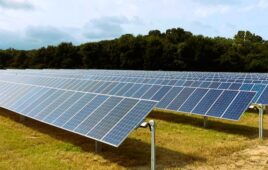The U.S. Department of Energy (DOE) announced an ambitious new target to cut the cost of solar energy by 60% within the next ten years, in addition to nearly $128 million in funding to lower costs, improve performance and speed the deployment of solar energy technologies. These investments support the Biden-Harris Administration’s climate goals and will pave the way for affordable decarbonization of the energy system and a robust clean energy economy.
“In many parts of the country, solar is already cheaper than coal and other fossil fuels, and with more innovation we can cut the cost again by more than half within the decade,” said Secretary of Energy Jennifer M. Granholm. “This first burst of funding will help us add even more affordable clean energy to the grid, jobs to communities across the country and will put us on the fast track toward President Biden’s goal of 100% clean electricity by 2035.”
Lowering the cost of solar energy is essential to accelerating deployment and achieving President Biden’s goal of a 100% clean electricity grid by 2035. To reach that goal in the next 15 years, the country will need to add hundreds of gigawatts of solar energy to the grid at a pace as much as five-times faster than current installation rates. To that end, DOE is accelerating its utility-scale solar 2030 cost target by five years — setting a new goal of driving down the current cost of 4.6 cents per kWh to 3 cents/kWh by 2025 and 2 cents/kWh by 2030.
“To meet our bold zero emissions goals by 2035, we need to unleash major investment in solar energy and technologies,” said U.S. Senator Edward J. Markey. “I am excited to see the Biden-Harris Administration and the Department of Energy grant the Massachusetts Institute of Technology (MIT) this research and development funding today to help the Commonwealth scale up our clean energy deployment and innovation. This funding will be a bright spot for the Massachusetts clean energy economy and will help us lower costs, create jobs, and deploy more gigawatts of solar than ever before.”
Traditional solar panels convert sunlight into electrical energy using PV solar technologies, which by 2035 could represent between 30% and 50% of electricity supply in a decarbonized electricity sector. Funding announced today through DOE’s Solar Energy Technologies Office (SETO) will support advancing two materials used to make solar cells: perovskites and cadmium telluride (CdTe) thin films.
- $40 million for perovskite R&D: Perovskites are a family of emerging solar materials that have potential to make highly efficient thin-film solar cells with very low production costs. DOE is awarding $40 million to 22 projects that will advance perovskite PV device and manufacturing research and development — as well as performance through the formation of a new $14 million testing center to provide neutral, independent validation of the performance of new perovskite devices.
- $3 million Perovskite Startup Prize: This new prize competition will speed entrepreneurs’ path to commercializing perovskite technologies by providing seed capital for their newly formed companies.
- $20 million for CdTe thin films: The National Renewable Energy Laboratory will set up a consortium to advance cheaper CdTe thin-film solar technologies, which were developed in the United States and make up 20% of the modules installed in this country. This consortium will advance low-cost manufacturing techniques and domestic research capabilities, increasing opportunities for U.S. workers and entrepreneurs to capture a larger portion of the $60 billion global solar manufacturing sector.
In addition, DOE announced $7 million as part of a new funding opportunity for projects to increase the lifetime of silicon-based PV systems from about 30 years to 50 years, lowering the cost of energy and reducing waste. The aim is to improve PV system components, such as inverters, connectors, cables, racks and trackers.
News item from DOE




Cutting the cost by 60% appears to be in the utility scale energy generation arena, where some of the recent large scale projects have come in with costs of around $1.40/watt installed over several thousands of acres of land. There’s the rub, as more solar PV farms are constructed, the more land leases or land pricing will rise, negating some of those “cost savings”. Ten years is the goal for 2 cents/kWh, is being done in the UAE on 1GWp solar PV farms at $19.50/MWh generation today. You could get wholesale electricity to 1 cent or even less per kWh and at the retail end, would be still packed with bundled costs that would make it expensive. Just a straight across example, in California the many electricity rate programs in place now have sliding scale electric rates, TOU rate spiking programs and the (average electric bill) is $0.20/kWh to $0.25/kWh. You might knock off 5 cents/kWh on wholesale, but the retail rates would stay the same or increase to grab assured revenues within the utility “regulated monopoly” authority.
“Traditional solar panels convert sunlight into electrical energy using PV solar technologies, which by 2035 could represent between 30% and 50% of electricity supply in a decarbonized electricity sector.’
There are some regions in California today that have right at100% of the electricity supplied right at 30% of the day and more is “curtailed” that could make what is online right now a 40% to 50% electricity generation capacity on a daily basis.
As far as ‘technologies’ in solar PV are concerned, the possibility of tandem cells using something like mono-crystalline with a ‘spray on’ layer of perovskite, could make the 30% efficient solar PV cell possible. Tandem or trinary perovskite cells could make the 40% efficient solar PV cell possible, (IF) degradation can be effectively dealt with. A useful easy to manufacture spray on manufacturing process that lasts 30 years would be the “no brainer” for future home and business construction. Right now First Solar owns the CdTe panel manufacturing and efficiency manufacturing point. It has already announced that by 2028 all of First Solar’s manufacturing facilities will be powered by solar PV. Manufacturing solar PV with solar PV derived energy has got to be a cheaper as well as more “carbon free” manufacturing process.
Damn solar man, sounds like you know what you’re talking about! Do you have a pod cast or a blog?
No pod cast or blog, there’s plenty of those out there, to read, post and argue on.
Let’s say I’ve been a student of how energy is developed, used, dispatched and priced for decades. For the last 16 years, I’ve been able to enjoy the benefits of solar PV on the roof of my first home, then, when that home was sold, now my second home has a larger array and at this time I’m saving for more solar PV and a smart ESS or Micro-grid set up. I picked Solarman years ago, when the solar PV industry was younger, folks then and sometimes now like to chirp the utility talking point(s) of ‘fairness’, ROI, and doesn’t pencil out. It is a relatively known premise that if you’re paying $0.12/kWh for electricity now, you could have solar PV installed and pay for the system in 15 years or less. IF you have plans to further electrify your home and get rid of natural gas, and or get a BEV or two, then the design criteria is install a solar PV array that is oversized, to help charge the BEV(s). What happens to one’s energy needs is two fold at that time. You are saving on electricity use every month, that money can go back into your household budget every month. With the BEV(s) and relatively short commutes one can charge at home and save on gasoline, add this back to the household budget every month also. Depending on the utility market pricing you’re in right now, when energy for transportation goes back into your pocket, you can pay for a solar PV system in less than 10 years and in some markets like California can do this in less than 5 years. Just sayin’ sites like this are valuable in determining how one can get off of the energy merry-go-round.